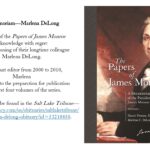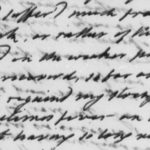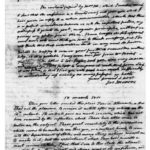Changing Scholarship: Reconsidering Eliza Monroe's Birthplace A recent review of a previously unknown manuscript has prompted a reconsideration of earlier scholarship regarding the birthplace of Eliza Monroe Hay. Her birth in early December 1786 had originally been understood to have occurred in Fredericksburg, but evidence now supports that she was instead born in King George County, likely at the farm of James Monroe's maternal uncle, Judge Joseph Jones. James Monroe met Elizabeth Kortright in New York during his service in Congress in 1785. They married in February the following year. Following the completion of his third Congressional term, Monroe proposed to move to Virginia with the intent of establishing a law practice, but vacillated between Richmond or Fredericksburg.[1] He was aided in this decision by Joseph Jones, a paternalistic figure to him, who counseled him regarding the saturated nature of the legal field and high cost of living in Richmond.[2] Alternatively, and … [Read more...]
In Memoriam—Marlena DeLong
In Memoriam—Marlena DeLong The staff of the Papers of James Monroe acknowledge with regret the recent passing of their longtime colleague Marlena DeLong. An assistant editor from 2000 to 2010, Marlena contributed to the preparation for publication of the first four volumes of the series. An obituary can be found in the Salt Lake Tribune. … [Read more...]
Monroe Myths: Presidential Pets
Presidential pets have long been a source of interest and delight for the American public. Dogs hold sway as a perennial favorite, but other White House pets have ranged from the unexpected (Andrew Jackson's parrot, Poll, who allegedly had to be removed from his funeral for swearing) to the disappointingly inaccurate (John Quincy Adams did not, in fact, keep a pet alligator in a White House bathtub) to the truly diverse (Calvin and Grace Coolidge fielded a range of animals, from raccoons to wallabys to lion cubs). Was James Monroe in the ranks of presidential pet owners? Myth: Several published works (and numerous websites) of presidential pet histories attribute two dogs to Monroe's ownership – a spaniel who lived with them in the White House, and a Siberian husky named Sebastian. Fact: Monroe's surviving correspondence is notoriously sparse for its commentary on matters of a personal nature, and this dearth extends to references to any four-legged members of his household. In … [Read more...]
Monroe Myths: James Monroe’s last words
"It falls to my lot to communicate to you the death of our excillent [sic] friend Mr Monroe. he died exactly at half past 3 oClock P.M after a lingering illness, but easy death. ... What a remarkable coincidence of the deaths of three of our venerable revolationary [sic] Patriots & Presidents" (Tench Ringgold to James Madison, 4 July 1831 [1]) Myth: Numerous sources of presidential trivia cite Monroe's last words as "I regret that I should leave this world without again beholding him," referencing his friend of four decades, James Madison. None of the websites or publications reviewed have provided a citation to verify sourcing. Fact: To date, Monroe's last words have not been identified. The account of his death is largely drawn from Tench Ringgold, who was Monroe's "...constant attendant & nurse" for the final months of his life and the author of the above-cited letter to Madison.[2] On 7 July, Ringgold shared a more complete account of Monroe's final months: "During … [Read more...]
New Blog Series: Monroe Myths
The ongoing research and publication of the Papers of James Monroe often brings its editors in contact with various myths and misconceptions connected to Monroe's life and writings - misattributed quotes, inaccurate biographical information, and speculation into personal matters. This well-intentioned content is often attempting to fill a vacuum created by Monroe himself. While his voluminous surviving correspondence of nearly 40,000 documents provides valuable insight into the the political development of the early Federal period of American history, his private nature left minimal insight into his detailed activities, personal matters, or private thoughts. The new blog series Monroe Myths will focus on corrections or clarifications to misinformation identified in the process of preparing Monroe's papers for publication, and will address both the serious ("What were Monroe's last words?") and the more lighthearted ("Did Monroe have a pet Siberian husky named Sebastian?"). While it … [Read more...]
“From this, I soon recovered…”
Epidemics of varying degrees were not uncommon in the 19th century. Washington, DC was especially notorious for its unhealthy atmosphere and saw frequent outbreaks of disease such as influenza and yellow fever. During one such period in April 1815, James Monroe wrote to Thomas Jefferson that he “...had suffer’d much from a very severe attack of the sciatick, or rather of the prevailing epidemick which seized on the weaker parts of the system. From this, I soon recoverd, so far as to attend to business, but have not yet regaind my strength, and am affected by cold & sometimes fever on the slightest exposure.” Monroe had written to James Madison earlier that month, inquiring after Dolley Madison’s health with regard to the same outbreak: “We hope that Mrs. Madison’s indisposition, was the effect of the fatigue of the journey only, and not the epidemic.” Historians often sit at the crossroads of the past and the present, and as such, find a modicum of reassurance in … [Read more...]
Flattening the Curve in 1800
James Monroe was no stranger to doing his part to flatten the curve. In August of 1800, during his first term as governor of Virginia, he instituted a quarantine on ships traveling from Norfolk into other port cities in an effort to reduce the spread of yellow fever throughout the Commonwealth. Quarantines for ships and their crews were not uncommon, and could last between 10–40 days. By the Governor of the Commonwealth of Virginia. A PROCLAMATION. WHEREAS satisfactory information has been received, that some contagious disease exists at Norfolk, which without due precaution, may be communicated to other parts of this Commonwealth, and it being the duty of the Executive, to prevent the spreading of the said disease, by causing the Laws made and provided for that purpose, to be faithfully executed:—I have therefore thought fit with the advice of the Council of State, to issue this Proclamation, injoining all vessels coming from the said port of Norfolk up James River, to … [Read more...]
Examining the Details
This post is the third in the series, "Documenting a First Lady" The note recently located in the archive at William & Mary is extremely short, but in examining its few details, we are able to make connections to the larger picture of the Monroes' life in Washington, D.C. The note reads: Mrs Monroe requests Mr Smith will be so good as send by the bearer Tom, one hundred Dollars to the account of Mr Monroe Saturday January 21th 1815 This is not the first reference to Elizabeth Monroe managing her own finances. Bank records from the Monroes’ time in Washington show her withdrawing money for her own uses on other occasions as well. Given the glimpses of her independence and decisiveness shown in other surviving documents, it does not come as a surprise to see her accessing her own accounts in this way. The “Mr Smith” to whom the note is addressed is Richard Smith, cashier of the Bank of the United States in Washington. The first record of the family's account with … [Read more...]
Documenting a First Lady
This post is the second in the series "Documenting a First Lady" When discussing First Lady Elizabeth Monroe and the paucity of her written record, the immediate follow-on question is nearly always “How many of her letters have survived?” Quantifying the documentary record of any historic figure relies heavily on semantics – specifically, what counts as a letter? As a document? Which are being considered? In this case, Mrs. Monroe's written records fall primarily into two categories: correspondence in which she is either the author or recipient, and documents written in her hand but that are not necessarily intended to be communicative, such as mortgages or transaction records, or instances where she assisted her husband in copying out his letters. By limiting the parameters to items where she is either author or recipient, rather than amanuensis or signatory, staff at the Papers of James Monroe are currently aware of six letters. These include three documents that … [Read more...]
New First Lady Document Identified
This post is the first in the series "Documenting a First Lady" Conditioned as we are to the accessible and often voluminous correspondence of many early Americans, it frequently comes as a surprise to both the public and scholars to find out that there are fewer than a half-dozen surviving documents written by Elizabeth Kortright Monroe. According to their daughter, Eliza Hay, James Monroe burned his wife’s correspondence following her death in 1830. Such an act would not have been considered unusual by their contemporaries, as individuals of this era held a strongly defined sense of what constituted private, rather than public, correspondence. To historians, however, the five letters that currently constitute Elizabeth Monroe’s entire body of correspondence function as a tarnished mirror, allowing only fleeting and incomplete glimpses of this enigmatic First Lady. For decades, only one letter in her handwriting was known to have survived. Addressed … [Read more...]





